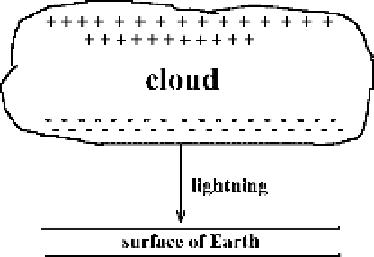Environmental Engineering Reference
In-Depth Information
Figure 6.23
Character of charging of the Earth's surface through a cloud when charge separa-
tion results from the falling of negatively charged water drops and charge transfer from a cloud
to the Earth's surface proceeds through lightning [153, 167].
U
300 kV) if we model the Earth as a spherical capacitor with one electrode as
the Earth's surface and the other electrode is a sphere at a distance of 6 km from
the Earth's surface. From this it follows that all the electric processes of the Earth's
atmosphere take place in low atmospheric layers at altitudes below approximately
10 km.
Our goal is to construct the scheme of processes which create the electric ma-
chine of the Earth. Because the Earth's atmosphere contains charged particles,
its conductivity determines the electric currents. The average current density
foraquietatmosphereoverlandis2.4
D
10
12
A/m
2
, and over the ocean it is
10
12
A/m
2
. This gives a total Earth current of approximately I
3.7
D
1700 A,
which leads to the Earth discharging in a time of typically
340 s,
that is, the time for the Earth to discharge owing to the conductivity of the
Earth is about 6min. If we take the average mobility of atmospheric ions to be
K
τ
D
Q
/
I
D
300 cm
3
.
We use the following simple scheme of the electric machine of the Earth's at-
mosphere [151]. The discharge of the Earth results from currents of positive and
negative atmospheric ions which are formed under the action of both cosmic radia-
tion and radioactivity of the Earth's surface. Charging of the Earth's surface begins
in clouds, where the positive and negative charges are separated, and the lower
cloud edge has a high electric potential with respect to the Earth's surface of 20-
100MV [152]. Subsequent lightning between the lower cloud edge and the Earth's
surface leads to charging of the Earth (see Figure 6.23 [153]).
Note that the character of charge separation in clouds as a result of the falling
of water aerosols depends on the sort of atmospheric ions, which may be different
depending on small admixtures to atmospheric air in a given region. Therefore,
the lower cloud edge may be charged both negatively and positively. Nevertheless,
the negative charge of the lower cloud edge is preferable. In reality, the number of
lightning discharges from clouds to the ground with transfer of the negative charge
to the Earth's surface exceeds that for transfer of positive charge by 2.1
2.3 cm
2
/(V cm), we find the average ion number density to be
N
i
D
D
0.5 times
on average [154]. The ratio of the amount of negative charge to positive charge
˙

